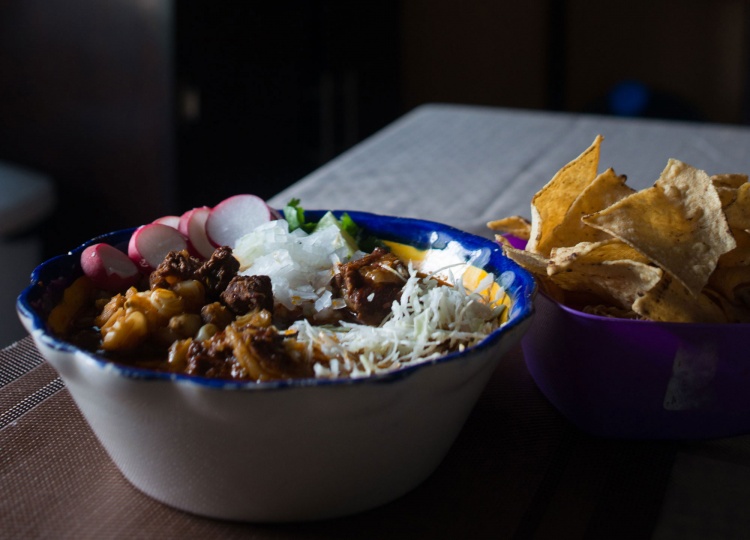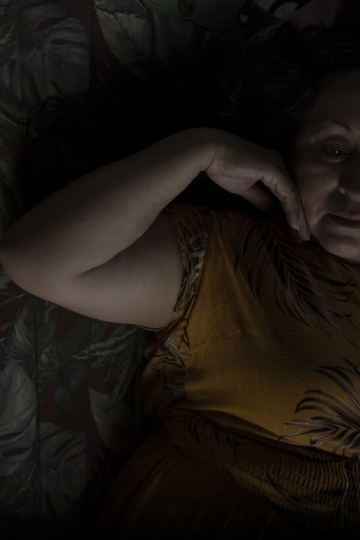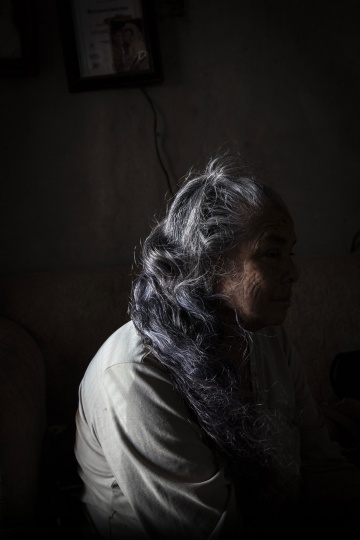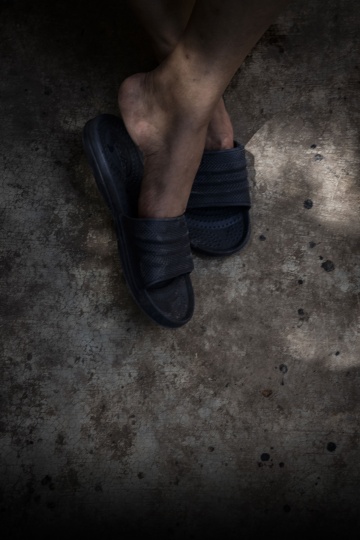A Feast for Lost Souls
The judges described A Feast for Lost Souls as a “deeply moving piece” that “stirs our collective empathy” and “gives voice to the unspeakable.” They praised writer Annelise Jolley and photographer Zahara Gómez Lucini for “letting their subjects grieve and breathe in their own time” and for providing the reader with a “real connection to their pain.” They applauded the team’s “exquisite attention to even the smallest of details,” and for respectfully shining a light on these “resilient, brilliant women” who possess "so much agency in the face of such devastation.” Originally published by The Atavist on November 30, 2021.

In Sinaloa, Mexico, women recover the bodies of missing loved ones — and cook to keep their memories of the dead alive.
Story by Annelise Jolley
Videos and Photographs by Zahara Gómez Lucini
The last time Blanca Soto saw her husband alive, he blew her a kiss.
It was the morning of November 28, 2016. Camilo was headed to Los Mochis, a city southwest of San Blas, the town in the Mexican state of Sinaloa where he and Blanca lived. Camilo told his wife that she didn’t need to run errands with him—she could stay home. Blanca insisted that he drive her as far as the local tailor’s shop.
When they arrived around 9 a.m., something inside Blanca told her not to get out of Camilo’s truck. But she did anyway, stepping onto the ground and closing the door behind her. “I remember that he was looking at me,” Blanca said. “He didn’t leave right away—he kept looking at me.” Camilo pressed his lips to his fingers, then turned his palm toward his wife.
Blanca moved to get back in the truck, but Camilo already had his eyes on the road. “That was when he drove away,” she said.
When she returned home on foot later that morning, Blanca was overtaken by an inexplicable sickness. First came a pain in her chest, then green vomit that rose up again and again in her throat. Later she would call this a foreboding, a warning.

Blanca went to the public prosecutor’s office, where officials told her she had to wait 48 hours before filing a missing persons report. She gave them Camilo’s name; her husband was a police officer. They took down her statement as a favor. Blanca went home and waited for a call, but one never came—not from the authorities, and not from Camilo.
When people vanish in Sinaloa, they’re almost never seen again. Sometimes drug cartels are responsible; in other cases state security forces are. Often the two sides are colluding—Mexico’s police and military are notoriously corrupt. People are taken because they work for cartels or because they refuse to. Because they buy drugs, sell them, or get in the way of the business. Because they’re in criminal gangs or are believed to be. Because they might be worth a ransom. Because they’re simply in the wrong place at the wrong time.
Every morning, Blanca walked to the gate outside her house fearing that she would discover Camilo’s body dumped in the road. She considered leaving town, seeking political asylum in America. But the desire to find her husband kept her in San Blas. She tried to move forward in small ways. She bought a new bed, rearranged the furniture, donated Camilo’s clothes and shoes. She purchased new appliances for the kitchen, hoping that cooking would steady her hands and keep her mind busy.
Pork pozole, a dark, rich stew, was Camilo’s favorite meal. He liked it spicy, the hotter the better, especially when he’d had several beers the night before and was nursing a hangover. Blanca knew the ingredients by heart: pork ribs, beef, hominy, bouillon, oregano, garlic, onion. But Blanca never made pozole anymore. She missed Camilo’s presence in the kitchen, how he placed his hands on her hips and told her to add more chiles: pasilla, guajillo. How he lifted her hair to blow on her neck. She feared that cooking the dish with only Camilo’s ghost by her side would feel like opening a wound.
Camilo had become one of the more than 90,000 husbands, sons, and fathers, wives, daughters, and mothers haunting Mexico. They are los desaparecidos—the disappeared. Blanca didn’t know what circumstances had led to her husband being taken, what he’d done or not done. And like many of the loved ones of Mexico’s missing, she didn’t care. All Blanca wanted was to find Camilo so that she could grieve properly.
Nothing more and nothing less.
Camilo had become one of the more than 90,000 husbands, sons, and fathers, wives, daughters, and mothers haunting Mexico. They are Los Desaparecidos —The Disappeared.
The countryside in northern Sinaloa is seared and blistered by heat. The landscape is dotted with low scrub brush and drooping palm trees, the green of their fronds muted by relentless sun. I would call the place dry, but the Spanish translation, seco, seems more appropriate—a word that siphons moisture from the back of the tongue when spoken.
As I drove toward Los Mochis on a July day, I watched Sinaloa’s scenery blur through the window. Men selling watermelons from truck beds. Roadside taco stands. Industrial complexes. Fallow fields. Soccer pitches. I wondered: Are bodies hidden there, or maybe there?

In contrast to Mexico’s highly visible violence—bodies strung up on bridges or left mutilated on roadsides as messages of intimidation—disappearances leave only questions in their wake. One day a person is there, and the next they are gone. Their loved ones are left to search for something, anything, tangible to mourn.
The impulse to bury the dead is ancient. It may even predate our species: In South Africa, paleo-archaeologists discovered fossilized bone fragments of Homo naledi in deep, nearly inaccessible cave chambers, hinting that pre-humans as far back as 300,000 years may have deliberately laid one another to rest. Early Homo sapiens made burial a rite. They interred bodies with shells, arrowheads, bird wings, and jewels. In Austria, the remains of babies some 27,000 years old were found buried with ivory-beaded animal skins under the shoulder blade of a mammoth, as if for protection.
Today burial is seen as the final physical act of tenderness the living can offer the dead. It provides a sense of completion, of having accompanied someone as far down the road of life as we can go with them. Funerary rites enshrine stories of faith, love, and sorrow, and graves offer the grieving a place they can return to again and again. “Just as the living need places to inhabit, so it is often in the nature of our memory-making to wish to be able to address our dead at particular sites of the Earth’s surface,” writes Robert Macfarlane in his book Underland: A Deep Time Journey. “The grief of those who have been unable to locate the bodies of their loved ones can be especially corrosive—acid and unhealing.”
This is the double cruelty of enforced disappearances: First comes the loss of a life, and then comes the denial of any chance to lay the body to rest.

Formed in 2014, Las Rastreadoras is one of these groups. It has some 200 members, most of them women from El Fuerte, a municipality in northern Sinaloa. They’ve all been touched in some way by enforced disappearances. Many have lost husbands or sons.
Criminal groups across Mexico dispose of bodies in distinctive ways—some burn them, others dissolve them in acid. In El Fuerte, the disappeared tend to be buried in shallow unmarked graves in the countryside. So Las Rastreadoras search the landscape with basic tools: shovels, machetes, spades, picks. The women dig in the dry earth, knowing that to properly bury their dead, they must unbury them first.
They don’t call what they’re looking for bodies, corpses, or remains. To Las Rastreadoras, the dead are tesoros—treasures.
Blanca Soto first heard about Las Rastreadoras before Camilo was disappeared. “I felt admiration for them, and at times sadness,” she said. But once her husband was gone, she was scared to join the women. She was paranoid that her own life might already be in danger, and she was wary of drawing attention to herself through public advocacy. Though Las Rastreadoras don’t seek to expose killers or put them behind bars—they only want to find and inter the dead—members of the group have received death threats. It wasn’t until April 2017, five months after Camilo was taken, that a cousin and a friend in Las Rastreadoras convinced Blanca to join a search.
Twice a week, on Wednesdays and Sundays, the group scours El Fuerte for human remains. Women who have yet to find their loved ones wear T-shirts printed with the slogan te buscaré hasta encontrarte (“I will search for you until I find you”). Women who have found their missing wear shirts that read promesa cumplida (“Promise fulfilled”).
Mirna Medina is the founder of Las Rastreadoras. A retired schoolteacher who talks fast and commands attention, Mirna has an uncanny memory for dates; her friends say that she remembers the day and year of every disappearance someone in her group is grieving. Mirna’s own date is July 10—the last time she saw her son Roberto alive. Three years to the day after he vanished, she found his remains: four vertebrae and a shard from an arm bone, identified by DNA analysis. Roberto’s was the 93rd body recovered by Las Rastreadoras. He’s now buried in a cemetery, where Mirna visits him. She lights candles, arranges flowers, and presses her fingertips to the photo on her son’s headstone.
Las Rastreadoras regularly receive tips about where bodies might be located. Sometimes the information is shared anonymously or by the police. In other cases a local resident spots something suspicious, such as a patch of turned soil. The women head out to these puntas (points), often accompanied by armed security. They trouble the earth with their tools, then plunge metal construction rods into the ground. When they pull the rods up, the tips are caked with soil. The women sniff the lingering dirt, hoping for a rotting odor—a tell-tale sign of human decomposition.
María Cleofas Lugo, whom everyone in the group calls Manqui, has searched for her son Juan Francisco since June 19, 2015. A photo of his face dangles in a silver frame from a chain around her neck. Manqui is the oldest woman in the group, and she is famed for her sense of smell. With the help of a rod, Manqui can discern what the earth beneath her holds. A clean musk means nothing is there. Sometimes a heavy funk of spoiled meat and sewage coats her nostrils and throat. When Manqui detects this, the smell of death, Las Rastreadoras dig.
Over the years, Manqui has learned the difference between the scent of a body and that of an animal carcass. “The smell of a human being is more penetrating,” she said. Many women can’t handle the odor. Manqui reminds them, “Yes, it smells bad, but it could be our children.”
When they uncover treasure, whether it’s a tooth or a torso, Las Rastreadoras pause over the site. They say a prayer, an Our Father or a Hail Mary. Then they alert the local government forensics team, which can test the DNA of the remains. The women hope for a match—that the treasure they’ve found belongs to someone on their list. Currently, Las Rastreadoras are looking for more than 1,500 missing persons; many are relatives or friends of the group’s members, but others are strangers whose names were supplied by people living in El Fuerte.
On her first dig, Blanca wasn’t sure what to do. She didn’t know how to use the tools or watch out for snakes or steel herself against the odor of death. “I went in eagerly but weak,” she said. “I was not a person who went out a lot.” At home, Blanca wore dresses and kept her long hair loose. She was proud of her delicate, shapely feet, which Camilo had always admired. On the search with Las Rastreadoras, the other women teased her because she showed up wearing gloves and carrying an umbrella, hoping to avoid the scorching Sinaloa sun. When Mirna handed her a shovel, Blanca stabbed it into the dirt with so much force that it rebounded into her chest, bringing tears to her eyes.
Blanca’s first search was a negative, which is how the women describe digs that don’t turn up remains. Her second was a positive. The group uncovered a body lying in the fetal position, still mostly intact. “The impression was something horrible,” Blanca said. When she saw the corpse, the air left her lungs and she fell backward. Other women, more seasoned trackers, were there to catch her. One gave Blanca an inhaler. They stayed by her side until she could stand again.
Week in and week out, Blanca continued to search with Las Rastreadoras. “Little by little, I kept on learning,” she said. But she was honing more than her skills with a shovel. Like the other trackers, she was also learning how, in lieu of a body and the closure it provides, to live with loss.
When she saw the corpse, the air left her lungs and she fell backward. Other women, more seasoned trackers, were there to catch her.
Over breakfast one morning in Los Mochis, Juana Escalante Barreras told me about her son, Adrián, who disappeared on August 24, 2018. In Juana’s words, Adrián was a Robin Hood. He rescued street dogs. He was skinny and always cold, but he’d give his sweater to anyone who asked.
The last time Juana saw Adrián, he was riding away from their house on his bike to deliver cigarettes to someone. Not long after he left, Juana heard gunshots. She felt her lungs constrict. She ran into the street shouting Adrián’s name, and she saw her son running toward her. He was being chased by a man with a gun. When Adrián turned a corner, Juana lost sight of them both. Two more gunshots rang out. Juana took off toward the sound. Rounding the corner, she saw two trucks peeling out, leaving the scent of burning rubber in the air. A neighbor was shouting, “They killed him, they killed him!”
There was blood at the place in the street where the trucks had been. The neighbor told Juana that Adrián had refused to get in one of the vehicles. He fought and tried to run, so the men in the trucks shot him and drove off with his body.
“Who could I talk to?” Juana asked me. “Who?”
Here she paused, as if I might have an answer. Then she continued: “I couldn’t talk to the police—the police aren’t going to do anything. There are thousands of people this is happening to.”

Juana’s nickname in Las Rastreadoras is Machete, for her blunt way of speaking, which cuts through bullshit. At one point, she fixed me with a stare over the rim of her coffee cup. Her eyes were dark pools above her full cheeks. I had told her that I was pregnant, a fact that narrowed the distance between us only slightly.
“You haven’t met your child,” she said. “I knew my son for 27 years. You can’t imagine my pain.”
“You’re right,” I said. “I can’t.”
Nor can I imagine Manqui’s pain. She knew her son, Juan Francisco, for 33 years. He was confident and a jokester. Even when things turned ugly in their neighborhood, he spoke flippantly about the sicarios, or cartel hit men; he was sure their violence wouldn’t affect him.
Juan Francisco was taken while he was installing lights at a job site. A red truck without plates pulled up, and the workers scattered, knowing that enforced disappearances were on the rise in the area. Juan Francisco tried to run, but an injured knee slowed him down. Manqui later heard that some men pulled her son into the truck, that they tried to recruit him to “take care of a job,” and that when he refused, they tortured and killed him.
Manqui went to the prosecutor’s office to file a report. She was told to wait 72 hours. Officials promised to call the other men from the job site for witness statements, but they never did. Manqui returned to the office every week, until a lawyer told her not to come back unless she’d found something worth adding to Juan Francisco’s file. She realized then that no one would search for her son except her.
In Manqui’s home, the walls are bare save for two wedding portraits and an oversize poster that hangs above the kitchen table. A photo of Juan Francisco’s face is plastered on it, a baseball cap shading his hooded eyes. te esperamos… ¡tu familia te ama!, the poster reads—“We’re waiting for you… Your family loves you!”

Mexico is a country that feeds its dead. Every year, bottles of Fanta and plates of pan dulce and pollo con mole adorn altars on Día de Muertos (the Day of the Dead). Food is a way of remembering and honoring those who’ve passed away. For Las Rastreadoras, it has become something more.
The idea to compile a cookbook arose a few years after the group formed. Photographer Zahara Gómez Lucini had spent time documenting Las Rastreadoras, and together she and the women came to a realization as cruel as it was inevitable: The problem with a decades-long issue like los desaparecidos is that the public grows weary of it—of hearing the names of the missing, of fathoming their ever growing numbers, of seeing photos of bodies and watching mothers weep. How, then, could Las Rastreadoras push back against the erasure of their loved ones? How could the women resist oblivion?
Food was the answer. All the women had memories of their missing that were tied to cooking and eating. They decided to gather recipes for the dishes their loved ones had enjoyed most. They would invite cookbook readers to taste their loss. The recipes would be reminders of the bonds the dead shared with family and friends, of the tables they sat around, of the pleasure they took in eating. The dishes would be proof of lives lived and lost, and portals to empathy.
What’s more, the women would create the book together. They would create something lasting from their collective sorrow. They would transform the mundane act of chopping onions, sifting flour, or caramelizing sugar into a sacrament.
Juana contributed her chipotle tuna sandwich recipe. Manqui shared her technique for making flan. Mirna, the group’s founder, described how to make pizzadillas: tortillas folded over roasted beef, pico de gallo, and cheese. All told, 27 women shared dishes for the project.
Recetario para la Memoria (“The Memory Recipe Book”) was published in 2019. In addition to the recipes, it features Zahara’s images of Las Rastreadoras preparing meals—of women creating the means of their physical and emotional survival. Many of them were photographed cooking their chosen dishes for the first time since their loved ones were disappeared.
Celebrated Mexican chefs, including Enrique Olvera and Eduardo García, both owners of haute cuisine destinations in Mexico City, have since endorsed the project. People as far away as Norway, South Africa, and Chile have sent messages of support and photos of the book’s dishes that they prepared in their own kitchens. The revenue from book sales have helped Las Rastreadoras cover the rent for an office in Los Mochis and pay for the necessities of their work, such as tools and gasoline.
The project has had more intimate benefits, too, which I witnessed firsthand. When talking about disappearances and death, the women of Las Rastreadoras were stoic; they could describe blood on a street or bones in the earth without flinching. But emotion clogged their voices when they talked about the food of the disappeared. Returning to familiar flavors they’d once shared with a child or a husband allowed grief to rush in and take shape, like seawater filling a hole dug in the sand. Cooking was a way to give voice to the unspeakable. It acknowledged the eternal absence of mouths the women longed to feed, of lives cut short by senseless violence.
Blanca contributed her pork pozole recipe to the cookbook. By then she was a veteran member of Las Rastreadoras—someone who went to the twice-weekly digs as often as she could, and who counted the group’s members as friends. She still does. On a weekend afternoon in 2021, Blanca met with several trackers at a restaurant near a beach south of Los Mochis. Over grilled fish, ceviche, and aguachile, the women teased and argued and bantered. Mentions of forensics and visits to the prosecutor’s office were punctuated by the snap of Tecate beer cans opening.
“Feasting allows the loneliness and terror of existence to be forgotten, at least momentarily,” anthropologist Gina Rae La Cerva has written. “Such pleasure brings us into that raw, mad, deep love of life.” Feasting can also be a venue for the sharing and salving of pain.
Some of the women at the table didn’t know Blanca’s story. It wasn’t for lack of caring. It was just that Blanca had been part of Las Rastreadoras for more than four years, and the group had grown much larger since she first joined. There were so many new faces, so many disappearances to keep track of, so many remains pulled from the ground.
“How did you find Camilo?” one woman asked as she passed tortillas down the table. “Tell us—or don’t, if you don’t feel like it.”
Blanca didn’t mind. As her friends ate, she began to speak.
Cooking was a way to give voice to the unspeakable. It acknowledged the eternal absence of mouths the women longed to feed, of lives cut short by senseless violence.
On a September night, Blanca lay awake in bed, praying. One of her sons had convinced her to start attending a Pentecostal church after Camilo disappeared, and she was becoming a devout believer. “Lord, I feel that I am ready,” Blanca said. “Tomorrow we’re going on a search. If you think I’m ready to find him, help me.”
When she woke the next morning, she repeated the prayer. She got dressed and stood outside her house, waiting to be picked up. The other women arrived in a truck, and Blanca climbed in. Only a few of Las Rastreadoras joined the dig that day. They didn’t have an exact point they were planning to search. Instead, they picked a general area and combed it together, until they saw loose or piled earth. Then they brought out their rods and shovels.
Mirna was the one who spotted fabric first, buried a few inches beneath soil and foliage. More digging revealed that it was a pair of men’s pants. Mirna called out the details to the other women: Oggi brand, black, size 34.
Blanca felt her hands jump to her mouth. It’s him, she thought. She repeated the words out loud.
She grabbed a shovel and worked to free the body from the earth’s hold. The other women joined her. Soon they could see socks and a pair of boxers. A torso and shoulders. Then nothing: The body was missing its head.
But Blanca saw all she needed to be sure. Camilo had repurposed a seatbelt from his truck to hold up his pants, the same seatbelt Blanca had once spilled fuchsia nail polish on. The belt that looped around the Oggi pants in the shallow grave was stained pink.
Nine months after he disappeared, Blanca had found her husband.
She buried Camilo a week later. Mirna and other women from Las Rastreadoras were by her side. As they walked into the cemetery, Blanca revisited the day of Camilo’s disappearance in her mind. Would he be alive if she’d stayed with him in the truck? Or would she be dead, too, leaving her sons parentless? These were questions she would live with forever.
At the cemetery, Camilo’s casket sat at the bottom of an open grave. After searching for her husband for so many months, Blanca felt that she should be the one to inter him. She approached one of the cemetery workers and asked to borrow his shovel. At first he refused, but Blanca was persistent, and the man gave in. As she turned soil into the grave, one of her friends began to sing.
When Blanca began crying too violently to wield the shovel any longer, a woman named Rosario took it from her hands and added earth on top of the casket. Then another woman took a turn, then another, until all the gathered members of Las Rastreadoras had helped to bury Blanca’s treasure.
A row of framed photos and diplomas line a wall in Blanca’s home. It reads as a summary of Camilo’s life. There are photos of him in a graduation cap, on the couch with one of his sons, standing at the edge of the ocean. A Rotary Club certificate dated October 2012 recognizes his “courage and above and beyond dedication, even at the cost of his life, to achieve public safety.”
The largest frame on the wall holds photos of the day Camilo’s body was found. One of Las Rastreadoras had brought a camera to the dig and captured Blanca the moment she understood what was in the earth. Next to the picture of Blanca’s recognition is a portrait of Camilo in a button-front shirt; he wears an inscrutable expression, with dark half-moons beneath his eyes. The photo is overlaid with the text misión cumplida (“Mission accomplished”).
On the other side of the wall, Blanca cooked pork pozole in the kitchen. When she first made the dish as part of the cookbook project, she wept through the process. This time she didn’t cry—she sang. On the kitchen table was a notebook with Minnie Mouse on the cover and pages filled with the handwritten lyrics of church hymns. Blanca had already memorized the melodies. “Sometimes when I’m cooking, I just start singing,” she told me. “I don’t have the words to describe how grateful I am to God.”
Blanca narrated the first step of the recipe—simmer the hominy for 45 minutes—then switched to a song:
I am marveling at what my God has done.
In the midst of my anguish,
In the midst of my pain,
In the midst of my sadness,
You have given me joy.
“Despite my height, my size, my abilities,” she said, “I have done so many things that, if my husband were here, I might not have done.” Pain, she explained, had made her strong.
She dropped pork ribs into the pot with the hominy and stirred the mixture with a long silver ladle. She halved a white onion, round as a tennis ball, and added it along with bouillon cubes. She plucked garlic cloves from a bowl and rolled them in her palms to strip the skin, then fished oregano from a plastic jar with her fingers. Both went into the pot.
Simmer until the meat is tender.
My eyes pricked from the tang of onion and oregano. Meanwhile, Blanca was thinking about another smell. She told me she sometimes got a whiff of Camilo around the house, of the 1 Million cologne he always wore.
Remove the ribs and seeds from two types of chiles.
The guajillo was deep red, the pasilla dark as loam. Blanca could imagine Camilo telling her, More spice, more! She gutted the chiles, rinsed them under the tap, and added them to a second pot, this one filled with boiling water. Another onion, quartered this time, went into the water, along with salt.
When the chiles are soft, blend them with spices. Add the mixture to the pork and hominy stew.
Blanca trimmed a bouquet of cilantro and some radishes for garnish. Then she topped the pozole with shredded cabbage, because that’s how Camilo liked it. She continued singing in a soft voice. Beneath the sound drifted a sea of memories: of walking down to the river with her husband, of bathing together, of the first time they danced.
She poured the stew into bowls, filling the vessels with grief and love. “Remember,” Blanca said, placing a steaming portion before me, “when you’re cooking for the person you love, when you cook with your heart as well as your hands, the food tastes better.”
To learn more about The Memory Recipe Book, click here.




































































































